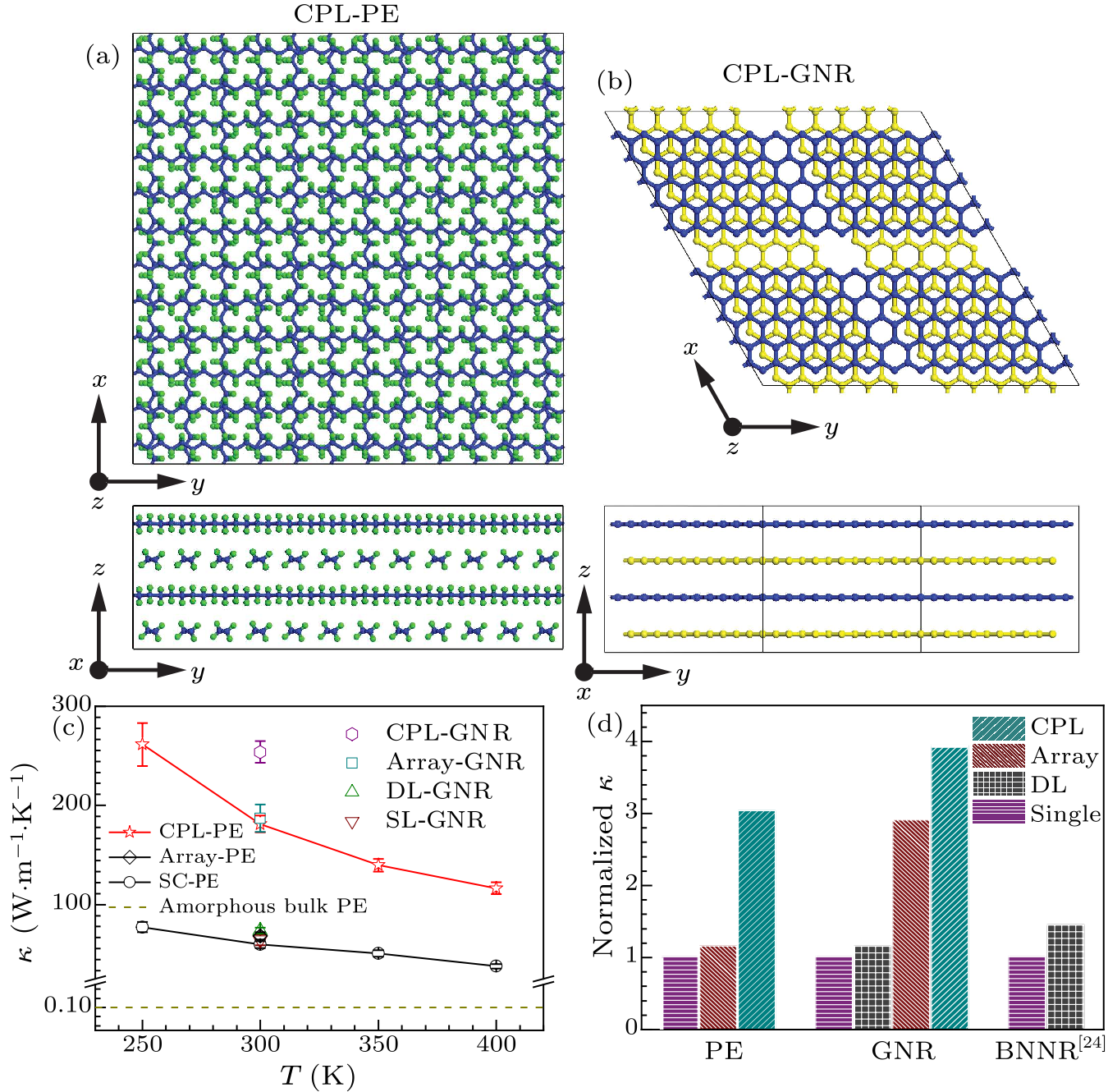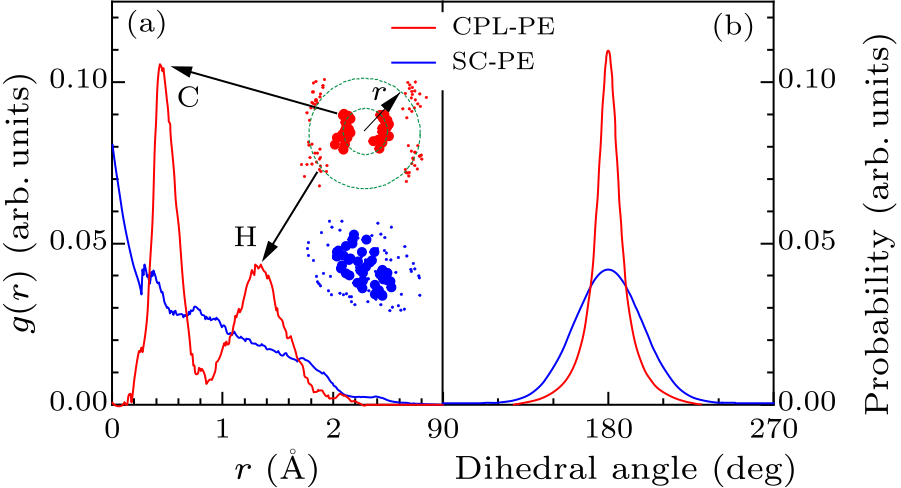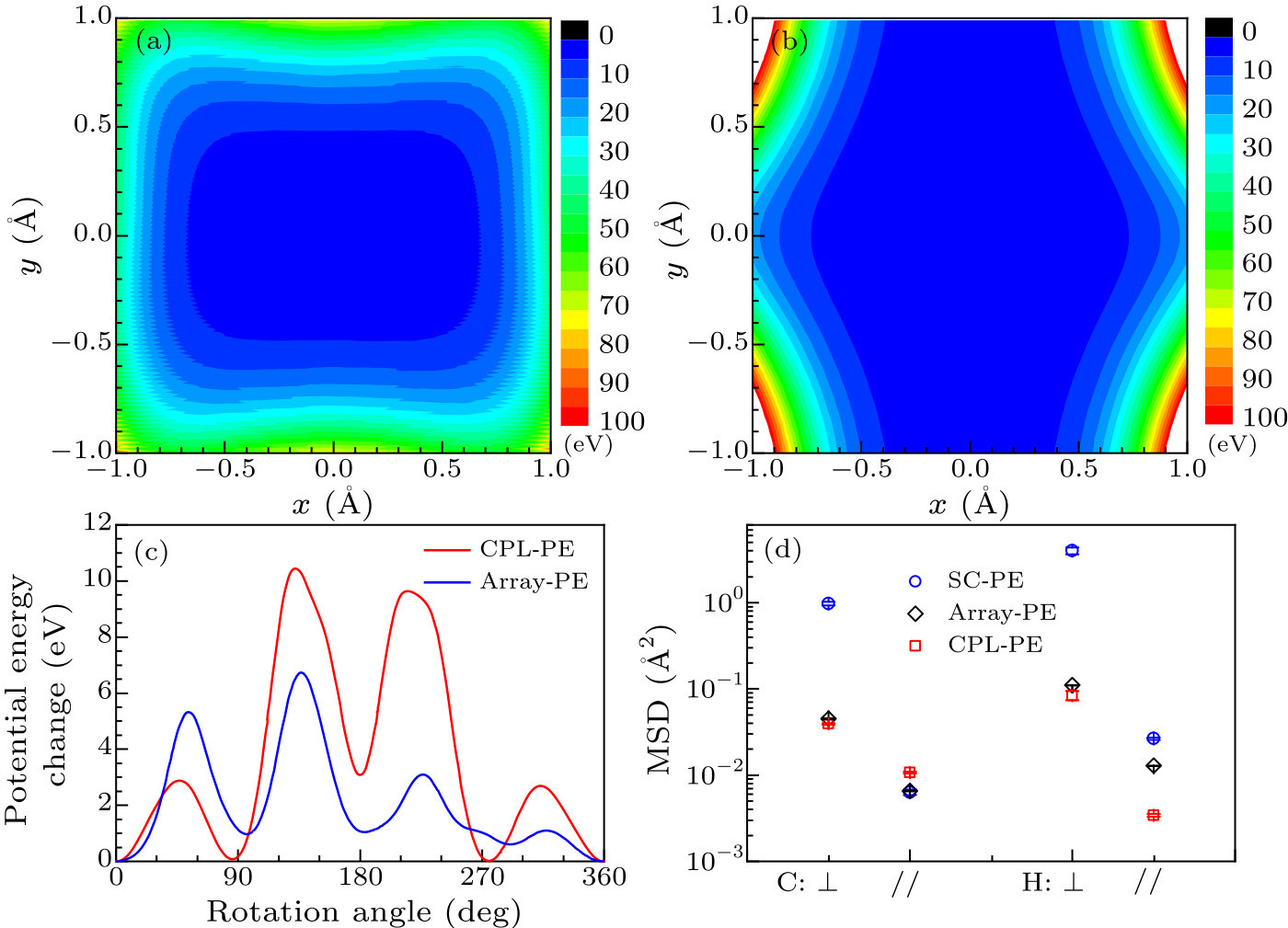
Fig. 1. (a) and (b) Schematic views of simulation cell of crosswise paved laminate (CPL) for polyethylene (PE) chain and graphene nanoribbon (GNR), respectively. (c) The thermal conductivities of PE chains and GNR systems versus temperature. (d) The ratios of thermal conductivity for structures with [CPL, array and double layer (DL)] and without vdW interactions (single chain/ribbon).

Fig. 2. (a) Radial distribution functions (RDFs) $g(r)$ of carbon and hydrogen atoms and (b) probability distributions of dihedral angles of C–C–C–C backbone in PE chain.

Fig. 3. The potential energy barriers of PE chain in (a) CPL-PE and (b) PE array. (c) The potential energy changes as a function of rotation angle. There is a confined vdW potential barrier in CPL-PE in comparison with PE array. (d) The mean square displacement (MSD) along radial ($\bot$) and axial ($\parallel$) directions of carbon and hydrogen atoms.
| [1] | Zhao R, Luo Y, Fernandezdominguez A I and Pendry J B 2013 Phys. Rev. Lett. 111 033602 | Description of van der Waals Interactions Using Transformation Optics
| [2] | Beguin L, Vernier A, Chicireanu R, Lahaye T and Browaeys A 2013 Phys. Rev. Lett. 110 263201 | Direct Measurement of the van der Waals Interaction between Two Rydberg Atoms
| [3] | Rao A M, Chen J, Richter E, Schlecht U, Eklund P C, Haddon R C, Venkateswaran U D, Kwon Y K and Tomanek D 2001 Phys. Rev. Lett. 86 3895 | Effect of van der Waals Interactions on the Raman Modes in Single Walled Carbon Nanotubes
| [4] | Woods L M, Dalvit D A R, Tkatchenko A, Rodriguez-Lopez P, Rodriguez A W and Podgornik R 2016 Rev. Mod. Phys. 88 045003 | Materials perspective on Casimir and van der Waals interactions
| [5] | Cardoso C, Soriano D, García-Martínez N A and Fernández-Rossier J 2018 Phys. Rev. Lett. 121 067701 | Van der Waals Spin Valves
| [6] | Mi X Y, Yu X, Yao K L, Huang X, Yang N and Lü J T 2015 Nano Lett. 15 5229 | Enhancing the Thermoelectric Figure of Merit by Low-Dimensional Electrical Transport in Phonon-Glass Crystals
| [7] | Lee J H, Avsar A, Jung J, Tan J Y, Watanabe K et al. 2015 Nano Lett. 15 319 | van der Waals Force: A Dominant Factor for Reactivity of Graphene
| [8] | Stornaiuolo M, De Kloe G E, Rucktooa P, Fish A, van Elk R et al. 2013 Nat. Commun. 4 1875 | Assembly of a π–π stack of ligands in the binding site of an acetylcholine-binding protein
| [9] | Seol J H, Jo I, Moore A L, Lindsay L, Aitken Z H et al. 2010 Science 328 213 | Two-Dimensional Phonon Transport in Supported Graphene
| [10] | Zhang X, Bao H and Hu M 2015 Nanoscale 7 6014 | Bilateral substrate effect on the thermal conductivity of two-dimensional silicon
| [11] | Ambrosetti A, Ferri N, Distasio R A and Tkatchenko A 2016 Science 351 1171 | Wavelike charge density fluctuations and van der Waals interactions at the nanoscale
| [12] | Baxter J, Bian Z X, Chen G, Danielson D, Dresselhaus M S et al. 2009 Energy & Environ. Sci. 2 559 | Nanoscale design to enable the revolution in renewable energy
| [13] | Yang L, Yang N and Li B 2014 Nano Lett. 14 1734 | Extreme Low Thermal Conductivity in Nanoscale 3D Si Phononic Crystal with Spherical Pores
| [14] | Ma D, Ding H, Meng H, Feng L, Wu Y, Shiomi J and Yang N 2016 Phys. Rev. B 94 165434 | Nano-cross-junction effect on phonon transport in silicon nanowire cages
| [15] | Dresselhaus M S, Chen G, Tang M Y, Yang R, Lee H, Wang D, Ren Z, Fleurial J P and Gogna P 2007 Adv. Mater. 19 1043 | New Directions for Low-Dimensional Thermoelectric Materials
| [16] | Shao C, Yu X, Yang N, Yue Y and Bao H 2017 Nanoscale Microscale Thermophys. Eng. 21 201 | A Review of Thermal Transport in Low-Dimensional Materials Under External Perturbation: Effect of Strain, Substrate, and Clustering
| [17] | Lindsay L, Broido D A and Mingo N 2011 Phys. Rev. B 83 235428 | Flexural phonons and thermal transport in multilayer graphene and graphite
| [18] | Ghosh S, Bao W, Nika D L, Subrina S, Pokatilov E P, Lau C N and Balandin A A 2010 Nat. Mater. 9 555 | Dimensional crossover of thermal transport in few-layer graphene
| [19] | Kuang Y, Lindsay L and Huang B 2015 Nano Lett. 15 6121 | Unusual Enhancement in Intrinsic Thermal Conductivity of Multilayer Graphene by Tensile Strains
| [20] | Yang N, Ni X, Jiang J W and Li B 2012 Appl. Phys. Lett. 100 093107 | How does folding modulate thermal conductivity of graphene?
| [21] | Hsu I K, Pettes M T, Bushmaker A, Aykol M, Shi L and Cronin S B 2009 Nano Lett. 9 590 | Optical Absorption and Thermal Transport of Individual Suspended Carbon Nanotube Bundles
| [22] | Lindsay L and Broido D A 2012 Phys. Rev. B 85 035436 | Theory of thermal transport in multilayer hexagonal boron nitride and nanotubes
| [23] | Fujii M, Zhang X, Xie H, Ago H, Takahashi K, Ikuta T, Abe H and Shimizu T 2005 Phys. Rev. Lett. 95 065502 | Measuring the Thermal Conductivity of a Single Carbon Nanotube
| [24] | Yang J, Yang Y, Waltermire S W, Wu X, Zhang H et al. 2012 Nat. Nanotechnol. 7 91 | Enhanced and switchable nanoscale thermal conduction due to van der Waals interfaces
| [25] | Zhang Q, Liu C, Liu X, Liu J, Cui Z et al. 2018 ACS Nano 12 2634 | Thermal Transport in Quasi-1D van der Waals Crystal Ta 2 Pd 3 Se 8 Nanowires: Size and Length Dependence
| [26] | Sun T, Wang J and Kang W 2013 Nanoscale 5 128 | Van der Waals interaction-tuned heat transfer in nanostructures
| [27] | Su R, Yuan Z, Wang J and Zheng Z 2015 Phys. Rev. E 91 012136 | Tunable heat conduction through coupled Fermi-Pasta-Ulam chains
| [28] | Wang X, Kaviany M and Huang B 2017 Nanoscale 9 18022 | Phonon coupling and transport in individual polyethylene chains: a comparison study with the bulk crystal
| [29] | Liu Y, Ma Y, Zhao Y, Sun X, Gandara F et al. 2016 Science 351 365 | Weaving of organic threads into a crystalline covalent organic framework
| [30] | Tavakkoli K G A, Nicaise S M, Gadelrab K R, Alexander-Katz A, Ross C A and Berggren K K 2016 Nat. Commun. 7 10518 | Multilayer block copolymer meshes by orthogonal self-assembly
| [31] | Lee J H, Koh C Y, Singer J P, Jeon S J, Maldovan M, Stein O and Thomas E L 2014 Adv. Mater. 26 532 | 25th Anniversary Article: Ordered Polymer Structures for the Engineering of Photons and Phonons
| [32] | Kubo R 1957 J. Phys. Soc. Jpn. 12 570 | Statistical-Mechanical Theory of Irreversible Processes. I. General Theory and Simple Applications to Magnetic and Conduction Problems
| [33] | Plimpton S 1995 J. Comput. Phys. 117 1 | Fast Parallel Algorithms for Short-Range Molecular Dynamics
| [34] | Narayan O and Ramaswamy S 2002 Phys. Rev. Lett. 89 200601 | Anomalous Heat Conduction in One-Dimensional Momentum-Conserving Systems
| [35] | Kundu A, Dhar A and Narayan O 2009 J. Stat. Mech.: Theory Exp. 2009 L03001 | The Green–Kubo formula for heat conduction in open systems
| [36] | Das S G, Dhar A and Narayan O 2014 J. Stat. Phys. 154 204 | Heat Conduction in the α−β Fermi–Pasta–Ulam Chain
| [37] | Tang N, Peng Z, Guo R, An M, Chen X, Li X, Yang N and Zang J 2017 Polymers 9 688 | Thermal Transport in Soft PAAm Hydrogels
| [38] | Li S, Yu X, Bao H and Yang N 2018 J. Phys. Chem. C 122 13140 | High Thermal Conductivity of Bulk Epoxy Resin by Bottom-Up Parallel-Linking and Strain: A Molecular Dynamics Study
| [39] | Stuart S J, Tutein A B and Harrison J A 2000 J. Chem. Phys. 112 6472 | A reactive potential for hydrocarbons with intermolecular interactions
| [40] | Henry A, Chen G, Plimpton S J and Thompson A 2010 Phys. Rev. B 82 144308 | 1D-to-3D transition of phonon heat conduction in polyethylene using molecular dynamics simulations
| [41] | Brenner D W, Shenderova O A, Harrison J A, Stuart S J, Ni B and Sinnott S B 2002 J. Phys.: Condens. Matter 14 783 | A second-generation reactive empirical bond order (REBO) potential energy expression for hydrocarbons
| [42] | Liu A and Stuart S J 2008 J. Comput. Chem. 29 601 | Empirical bond-order potential for hydrocarbons: Adaptive treatment of van der Waals interactions
| [43] | Henry A and Chen G 2008 Phys. Rev. Lett. 101 235502 | High Thermal Conductivity of Single Polyethylene Chains Using Molecular Dynamics Simulations
| [44] | Ye Z Q, Cao B Y, Yao W J, Feng T and Ruan X 2015 Carbon 93 915 | Spectral phonon thermal properties in graphene nanoribbons
| [45] | Zhang T and Luo T 2012 J. Appl. Phys. 112 094304 | Morphology-influenced thermal conductivity of polyethylene single chains and crystalline fibers
| [46] | Liao Q, Liu Z, Liu W, Deng C and Yang N 2015 Sci. Rep. 5 16543 | Extremely High Thermal Conductivity of Aligned Carbon Nanotube-Polyethylene Composites
| [47] | Yang N, Xu X, Zhang G and Li B 2012 AIP Adv. 2 041410 | Thermal transport in nanostructures
| [48] | Parrish K D, Jain A, Larkin J M, Saidi W A and McGaughey A J H 2014 Phys. Rev. B 90 235201 | Origins of thermal conductivity changes in strained crystals
| [49] | Shulumba N, Hellman O and Minnich A J 2017 Phys. Rev. Lett. 119 185901 | Lattice Thermal Conductivity of Polyethylene Molecular Crystals from First-Principles Including Nuclear Quantum Effects
| [50] | Wang L and Li B 2008 Phys. Rev. Lett. 101 267203 | Thermal Memory: A Storage of Phononic Information
| [51] | Liao B, Qiu B, Zhou J, Huberman S, Esfarjani K and Chen G 2015 Phys. Rev. Lett. 114 115901 | Significant Reduction of Lattice Thermal Conductivity by the Electron-Phonon Interaction in Silicon with High Carrier Concentrations: A First-Principles Study
| [52] | Oyake T, Feng L, Shiga T, Isogawa M, Nakamura Y and Shiomi J 2018 Phys. Rev. Lett. 120 045901 | Ultimate Confinement of Phonon Propagation in Silicon Nanocrystalline Structure
| [53] | Liao B, Zhou J and Chen G 2014 Phys. Rev. Lett. 113 025902 | Generalized Two-Temperature Model for Coupled Phonon-Magnon Diffusion
| [54] | Tamm A, Caro M, Caro A, Samolyuk G, Klintenberg M and Correa A A 2018 Phys. Rev. Lett. 120 185501 | Langevin Dynamics with Spatial Correlations as a Model for Electron-Phonon Coupling
| [55] | Ihle D 1977 Phys. Status Solidi B 80 619 | Electrical Conductivity in the Hubbard Model Including Electron-Phonon Interaction
| [56] | Waldecker L, Bertoni R, Hubener H, Brumme T, Vasileiadis T, Zahn D, Rubio A and Ernstorfer R 2017 Phys. Rev. Lett. 119 036803 | Momentum-Resolved View of Electron-Phonon Coupling in Multilayer
| [57] | Ma W L, Yang C Y, Gong X, Lee K and Heeger A J 2005 Adv. Funct. Mater. 15 1617 | Thermally Stable, Efficient Polymer Solar Cells with Nanoscale Control of the Interpenetrating Network Morphology
| [58] | Furchi M M, Pospischil A, Libisch F, Burgdorfer J and Mueller T 2014 Nano Lett. 14 4785 | Photovoltaic Effect in an Electrically Tunable van der Waals Heterojunction